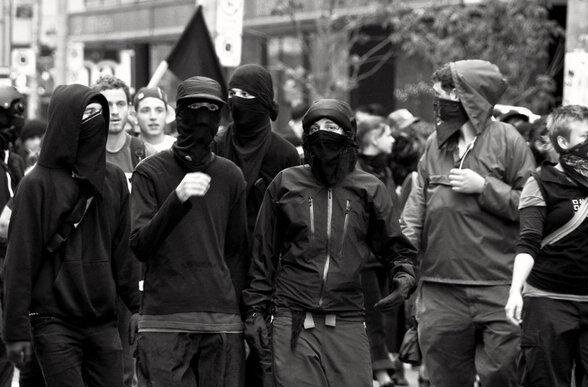Feminist Global Resistance will be posting a series of articles on techniques and safety tips for activists.
Our next article, “What is Black Bloc?”, was written in conjunction with our friends. In every action, there may be a variety of tactics used. Be aware of those tactics and understand their uses and their usefulness.
To all activists, “dancing the streets” or participating in any form of action, activism requires a knowledge of what one may encounter during any action. Be prepared for any event and stay vigilant.
Remember, we are in this together so together we help each other.
Activism can be fun but it is serious business – take care of yourself and each other.
As always: Be prepared for confrontation and keep it safe out there!
Love and Solidarity!

Activist Action Series: What is Black Bloc?
Black Bloc, is a defensive tactic, not a group. Those who practice it often wear black and cover their face with masks. Many who involve themselves in Black Bloc tactics are not necessarily people who are at protests solely to break things, although such types of people do come in and cause problems, at times giving this defensive tactic some scrutiny among the average citizen especially with the media’s portrayal. To understand why Black Bloc is a defensive tactic one must understand its history.
Black Bloc came out of the autonomous movement in Germany in the 1980s, specifically, West Germany, where “radical feminists” had a profound effect on the Autonomen (Autonomous Movement), injecting the movement with a more anarchist spirit than was the case elsewhere in Western Europe. The Autonomen expressed their politics via “rent strikes and re-appropriating hundreds of buildings which were turned into squats” that doubled as spaces for political activity.
There is no definitive moment when the term Black Bloc came into usage, although there are different stories. The first major arrival of a Black Bloc was in 1986, when a massive black bloc was formed to defend the Hafenstrasse squat. 1,500 black blockers and 10,000 other demonstrators confronted the police and saved the squat.
Over time and across the oceans Black Bloc soon spread to North America. Its rise has been explained over different periods and places where the existence of collective action was deemed effective and legitimate for the defense and promotion of a cause. From Seattle in 1999 to OWS and, most recently, the G20 Summit’s “Welcome to Hell”, there may be a use of force, but, more often than not, they are content to protest peacefully with the main objective being to embody, within a demonstration, as a radical critique of the economic and political system and acting as a deterrent so that other protestors voices can be heard. Often this is done by causing a distraction blocks away to draw the police state away from the other peaceful protestors.
To separate tactics some organizations have employed a color scheme there were three zones: green, yellow, and red. The green zone was a sanctuary where demonstrators were, theoretically, in no danger of being arrested; The yellow zone was for those undertaking nonviolent civil disobedience and involved a minor risk of arrest; The red zone was for protesters who were ready for more aggressive tactics, including skirmishes with the police.
While not everyone can agree on the tactics, I feel that all tactics have a place or, in fact, change is ever to occur. Whether it be peaceful protestors, III%, or Black Bloc, all of us must come together for one common goal change and prosperity for all.


